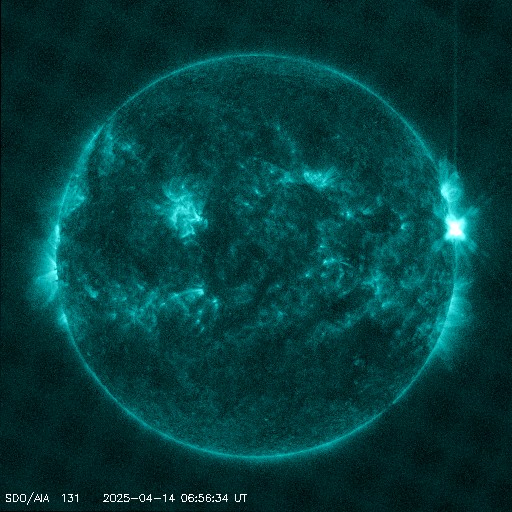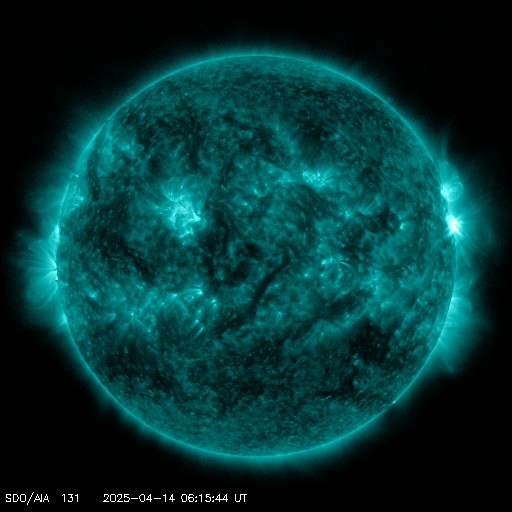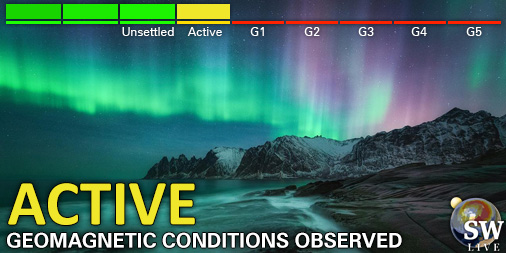Viewing archive of Saturday, 18 August 2012
Solar activity report
Any mentioned solar flare in this report has a scaling factor applied by the Space Weather Prediction Center (SWPC). Because of the SWPC scaling factor, solar flares are reported as 42% smaller than for the science quality data. The scaling factor has been removed from our archived solar flare data to reflect the true physical units.
Report of Solar-Geophysical Activity 2012 Aug 18 2200 UTCPrepared by the NOAA © SWPC and processed by SpaceWeatherLive.com
Joint USAF/NOAA Report of Solar and Geophysical Activity
SDF Number 231 Issued at 2200Z on 18 Aug 2012IA. Analysis of Solar Active Regions and Activity from 17-2100Z to 18-2100Z
Solar activity was high. Region 1548 (N19E86) produced
an M5/Sf flare at 18/0102Z, accompanied by a Tenflare (150 pfu). An
M1/Sn flare from the same region followed at 18/0323Z, also
accompanied by a Tenflare (120 pfu). Finally, an M2/1N occurred at
18/1607Z. Several coronal mass ejections (CMEs) were observed in
the past 24 hours, none appear to have a geoeffective component.
SDO 304 imagery showed a filament eruption in the vicinity of Region
1543 (N23W74) around 17/16Z. A CME was subsequently observed in
LASCO C2 coronagraph imagery at 17/1836Z, and in LASCO C3 imagery at
17/1918Z. A second filament eruption and CME was observed near
Region 1543 between 17/22Z and 18/0034Z. It was visible in STEREO-B
COR2 imagery at 18/0110Z and in LASCO C3 imagery at 18/0454Z. This
CME was directed well north of the ecliptic.
IB. Solar Activity Forecast
Solar activity is expected to be low
with moderate activity likely for the next three days (19-21
August).
IIA. Geophysical Activity Summary 17-2100Z to 18-2100Z
The geomagnetic field was quiet to active. Solar wind speed at the
ACE spacecraft ranged between about 350-420 km/s during the period.
The Bz component of the interplanetary magnetic field ranged between
-8 and +12 nT. Solar wind density at ACE increased sharply after
18/19Z. The geomagnetic field reached active levels during the last
period (18-21Z) coincident with a change to the positive sector and
the arrival of the corotating active region.
IIB. Geophysical Activity Forecast
The geomagnetic field is
expected to be quiet to unsettled for the next three days (19-21
August) as a corotating interaction region and coronal hole high
speed stream become geoeffective.
III. Event Probabilities 19 Aug to 21 Aug
| Class M | 55% | 55% | 55% |
| Class X | 05% | 05% | 05% |
| Proton | 01% | 01% | 01% |
| PCAF | Green | ||
IV. Penticton 10.7 cm Flux
Observed 18 Aug 097 Predicted 19 Aug-21 Aug 100/100/100 90 Day Mean 18 Aug 125
V. Geomagnetic A Indices
Observed Afr/Ap 17 Aug 011/011 Estimated Afr/Ap 18 Aug 009/011 Predicted Afr/Ap 19 Aug-21 Aug 010/012-011/012-007/008
VI. Geomagnetic Activity Probabilities 19 Aug to 21 Aug
| A. Middle Latitudes | |||
|---|---|---|---|
| Active | 20% | 20% | 10% |
| Minor storm | 05% | 05% | 05% |
| Major-severe storm | 01% | 01% | 01% |
| B. High Latitudes | |||
|---|---|---|---|
| Active | 20% | 20% | 15% |
| Minor storm | 30% | 30% | 20% |
| Major-severe storm | 25% | 25% | 15% |
All times in UTC
Current data suggests there is a slight possibility for aurora to appear at the following high latitude regions in the near future
Arkhangelsk, VorkutaLatest news
Latest forum messages
Incoming & Unnumbered Active Regions 1698AR 4060 23Unspecified geomagnetic activity 22532025/04/12-13 Filament CMEs 2025/04/16 G2 Watch 29Potential AR4062 4
More topicsSupport SpaceWeatherLive.com!
A lot of people come to SpaceWeatherLive to follow the Sun's activity or if there is aurora to be seen, but with more traffic comes higher server costs. Consider a donation if you enjoy SpaceWeatherLive so we can keep the website online!

Latest alerts
07:09 UTC - Solar flare
Moderate M4.28 flare from sunspot region 4055
06:48 UTC - Radio Blackout
Minor R1 radio blackout in progress (≥M1 - current: M1.53)
06:24 UTC - Solar flare
Moderate M1.49 flare from sunspot region 4055
06:06 UTC - Radio Blackout
Minor R1 radio blackout in progress (≥M1 - current: M1.16)
04:45 UTC - Geomagnetic activity
Active geomagnetic conditions (Kp4) Threshold Reached: 04:29 UTC
Space weather facts
| Last X-flare | 2025/03/28 | X1.1 |
| Last M-flare | 2025/04/14 | M4.2 |
| Last geomagnetic storm | 2025/04/06 | Kp5 (G1) |
| Spotless days | |
|---|---|
| Last spotless day | 2022/06/08 |
| Monthly mean Sunspot Number | |
|---|---|
| March 2025 | 134.2 -20.4 |
| April 2025 | 132.1 -2.1 |
| Last 30 days | 132.4 -10.7 |





